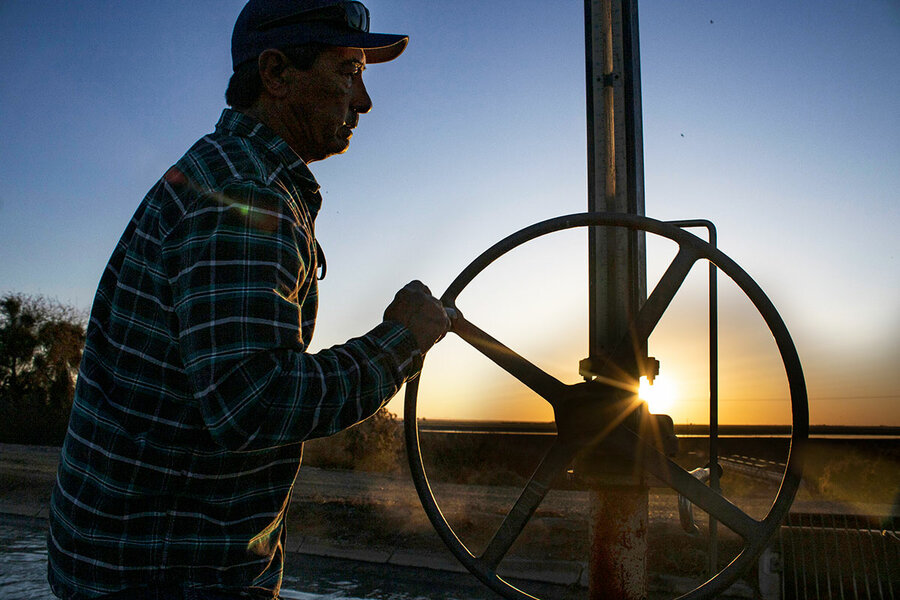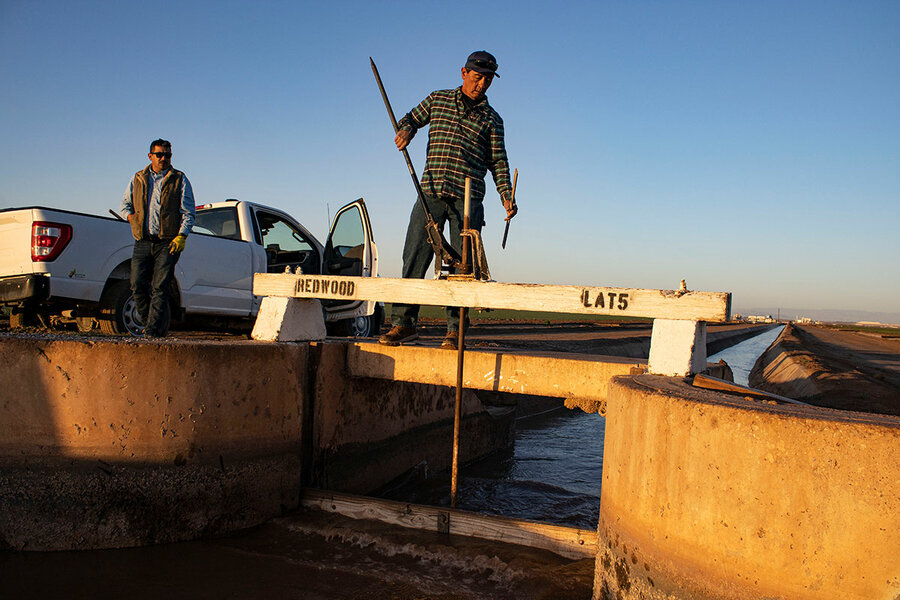Relay race: How ‘zanjeros’ get Colorado River water to California farms
Loading...
| Holtville, Calif.
Beginning his workday at 6 a.m. in southeastern California’s Imperial Valley, Jeff Dollente delivers Colorado River water to farms that feed the rest of the United States. He’s a “zanjero,” Spanish for ditch rider.
Strained by overuse and the effects of climate change, the river is facing critical lows, which are unlikely to reverse due to recent heavy rain and snow, experts say.
Why We Wrote This
A story focused onThe Colorado River crisis has heightened calls for conservation. Meet one of the people responsible for delivering – and safeguarding – the river’s liquid gold.
“That’s what we’re here for – trying to save the water,” Mr. Dollente says.
It’s a high-stakes relay race. From the Imperial Dam, water flows into the major All-American Canal, which feeds into three main canals, and then is directed into a series of lateral canals. Zanjeros usher that water to delivery gates at the edge of farm fields, according to how much has been ordered. At one stop, Mr. Dollente raises another type of gate a mere inch higher to adjust the flow.
“They’re the face of the district to the farmer,” says Ralph Strahm, co-owner of Strahm Farms Inc. in Holtville. “They’re the ones that save the system from breaching if there’s a problem.”
Work is often solitary for the zanjero, but Mr. Dollente is never quite alone. Coyotes pass by, roosters crow. And water sounds like gossip when it rushes through a ditch.
In the right light, Jeff Dollente seems to make the sun rise. Standing over a canal, he cranks a wheel as the sun ascends and the sky yawns off the dark.
Mr. Dollente doesn’t deliver the morning, but in southeastern California’s Imperial Valley, his job is just as big. He delivers Colorado River water – a vital resource at risk – to farms that feed the rest of the United States.
He’s a “zanjero,” Spanish for ditch rider, for the Imperial Irrigation District, the area’s public-water and energy agency. California is entitled to the largest share of Colorado River water among seven basin states, and within that, the agency has the single largest entitlement, almost all of which goes to agriculture. Upping the ante: The river is the Imperial Irrigation District’s only water source.
Why We Wrote This
A story focused onThe Colorado River crisis has heightened calls for conservation. Meet one of the people responsible for delivering – and safeguarding – the river’s liquid gold.
The crisis on the Colorado River, strained by overuse and the effects of climate change, is unlikely to reverse due to recent heavy rain and snow, experts say. While critical lows along the river threaten water supplies and hydropower, California hasn’t agreed with other states this year on who should conserve how much – though the Imperial Valley is a controversial target of calls for cuts.
As the federal government prepares to weigh in and high-level talks continue, so do zanjero daily duties on the ground. It takes focus and precision to safeguard each drop of liquid gold.
“We hear about it every day,” says Mr. Dollente, referring to the Colorado River. “That’s what we’re here for – trying to save the water.”
“Like a milkman”
Mr. Dollente reports for duty in the “Carrot Capital of the World,” also known as Holtville. He’s low-key but loyal to his work, arriving for an interview with two pages of typed notes.
At a division office, he’s greeted with a daily run sheet outlining his deliveries. In jeans and plaid shirt, the zanjero wears shades on the brim of his baseball cap. It’s dark outside – not yet 6 a.m. – but by the end of his eight-hour shift, the February sun will burn bright. Warmer months bring triple-digit heat.
“Live down here, you get used to it,” says the Holtville local, who joined the district out of high school in 1985.
The Imperial Irrigation District is entitled to 3.1 million acre-feet of Colorado River water a year, though it uses less. (In 2021, for example, the district reports conserving 485,709 acre-feet.) The district also has among the most senior water rights on the river; junior water rights holders are generally expected to take cuts first. Imperial Valley growers – touting their efforts in farm-based conservation – are trying to hold on to a water-intensive farming tradition that’s more than a century old.
Greening nearly half a million acres of farmland flanked by desert, the district gets its Colorado River water from the Imperial Dam on the California-Arizona border. The water nourishes alfalfa, winter vegetables, and other crops to the west – passing through some 3,000 miles of canals and drains – and then runs off into the Salton Sea. Robert Schettler, public information officer, calls it a daily miracle.
“There’s a tremendous amount of coordination,” says Mr. Schettler.
It’s a high-stakes relay race. From the Imperial Dam, water flows into the major All-American Canal, which feeds into three main canals, and then is directed into a series of lateral canals. Zanjeros – who oversee the lateral canals 24/7 – usher that water to delivery gates at the edge of farm fields, according to how much has been ordered.
“Like a milkman,” Mr. Dollente says.
Today on the Redwood Canal, he’s tasked with delivering water measured in cubic feet per second. At one stop, he raises a gate a mere inch higher to adjust the flow.
“They’re the face of the district to the farmer,” says Ralph Strahm, co-owner of Strahm Farms Inc. in Holtville. “They’re the ones that save the system from breaching if there’s a problem.”
Some days are stressful for Mr. Dollente. But he’s never fallen in. He’ll often clean canals of trash – a tumbleweed today. One time he found a cow, another time a gun.
Coyotes, roosters, and water
The water district employs around 140 zanjeros, currently all male. An experienced zanjero can make around $85,000, according to Mr. Schettler. (As of 2021, the census put the Imperial County median household income around $49,000.)
The term comes from the word zanja, or ditch, and describes part of the irrigation practices introduced by Spanish settlers in what would become California. Zanjeros have worked for the Imperial Irrigation District since it formed in 1911, once living in houses near the waterways they tended.
“They’re very valuable,” says Benny Andrés Jr., associate professor of history at the University of North Carolina, Charlotte, who’s from the Imperial Valley. “It’s a job that no one thinks about or knows about, but it’s very important.”
The role has also evolved alongside technology like cellphones. Mr. Strahm, the farmer, works closely with zanjeros and keeps their contacts in his phone. Still, he says he’d like to see the water district adopt more automation, which is widespread but most extensive along the larger canals, to support conservation.
“We need more accurate and timely delivery of water with recording devices to alert the zanjero when the water fluctuates,” says the grower.
Water-saving measures that he favors, like sprinkler or drip irrigation, don’t work when water fluctuates, he adds. “If there’s too little, the system shuts off. And if there’s too much, it can’t be used. It just goes to waste.”
Mr. Dollente agrees that enhanced automation would help with precision and conservation, though it’s considered expensive by the district. Some low-tech traditions have endured, like the yardsticks he uses for some measurements. But zanjeros no longer survey waterways on horseback.
Instead, Mr. Dollente travels with a laptop in one of the district’s white trucks, passing other white vehicles driven by U.S. Border Patrol. The two agencies are part of a safety campaign, reports the Calexico Chronicle, to stop drownings in the All-American Canal, which runs parallel to the Mexican border.
Work is often solitary for the zanjero, but he’s never quite alone. Coyotes pass by, roosters crow. And water sounds like gossip when it rushes through a ditch.











